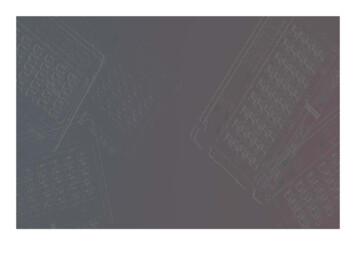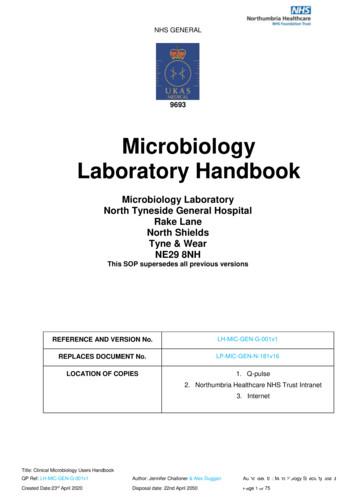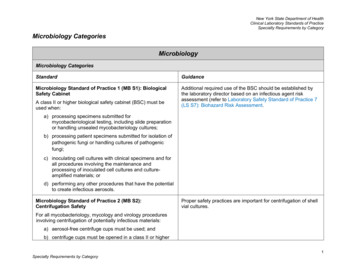Fundamentals Of Microbiology, Eleventh Edition
Jones & Bartlett Learning, 2017This item was created as a helpful tool for you, our valued customer,and is not intended for resale, dissemination, or duplication.Fundamentals of Microbiology, Eleventh EditionIncludes Navigate 2 Advantage AccessJeffrey C. Pommerville, PhD, Glendale Community CollegeISBN-13: 978-1-284-10095-2Hardcover with Access Code 944 Pages 2018Jones & Bartlett LearningSEE WHAT’S NEW TO THE ELEVENTH EDITION!Contact Your Publisher’s Representative For More Information1-800-832-0034 info@jblearning.com www.jblearning.com
Jones & Bartlett Learning, 2017This Transition Guide outlines many of the changes and new content in theEleventh Edition. Use this guide for an easy transition to the new edition.Of Course.Pommerville’s Fundamentals of Microbiology has done it again, as the easy choice forintroductory microbiology was just made easier. Now with a new modern and intuitive design,a deeper focus on career application, and exciting new features, the Eleventh Edition has raisedthe bar for introductory microbiology textbooks.Fundamentals of Microbiology is a true learning solution. Jeff Pommerville invites you todiscover microbiology as no other author can, with his relatable examples and smooth writingstyle. Features such as Investigating the Microbial World, MicroInquiry, and Chapter Challengesare student-friendly resources designed to teach concepts and encourage practical application.Instructors will be pleased to find the organizational framework of the text reflects theCurriculum Guidelines for Undergraduate Microbiology as recommended by the AmericanSociety for Microbiology and also addresses the AAAS “Vision and Change” recommendations.Key Features to the Eleventh Edition All the core principles of microbiology are here, including cell structure and function,metabolic pathways, information flow and genetics, microbial systems, and impactof microorganisms. NEW stunning interior design with over 575 NEW and revised illustrations thatunlock complex topics and biological processes NEW clinical case studies throughout for application to nursing and health sciencesIncludes the latest on Zika and Ebola viruses NEW information on the human microbiome Over 100 minutes of NEW Laboratory videos available* (*See below for packagedetails)Contact Your Publisher’s Representative For More Information1-800-832-0034 info@jblearning.com www.jblearning.com
Jones & Bartlett Learning, 2017CHAPTER OUTLINETable of Contents comparison to transition from the Tenth to the Eleventh Edition10th EditionPart 1: Foundations of MicrobiologyChapter 1: Microbiology: Then and NowChapter 2: The Chemical Building Blocks ofLifeChapter 3: Concepts and Tools for StudyingMicroorganismsChapter 4: Structure of Bacterial and ArchaealCellsChapter 5: Microbial Growth and NutritionChapter 6: Metabolism of MicroorganismsChapter 7: Control of Microogranisms:Physical and Chemical MethodsPart 2: The Genetics of MicroorganismsChapter 8: Microbial GeneticsChapter 9: Gene Transfer, GeneticEngineering, and GenomicsPart 3: Bacterial Diseases of HumansChapter 10: Airborne Bacterial DiseasesChapter 11: Foodborne and WaterborneBacterial DiseasesChapter 12: Soilborne and ArthropodborneBacterial DiseasesChapter 13: Sexually Transmitted and ContactTransmitted Bacterial DiseasesPart 4: Viruses and EukaryoticMicroorganismsChapter 14: The Viruses and Virus-Like AgentsChapter 15: Viral Infections of the RespiratoryTract and SkinChapter 16: Viral Infections of the Blood,Lymphatic, Gastrointestinal, and NervousSystemsChapter 17: Eukaryotic Microogranisms: TheFungi11th EditionPart 1: Foundations of MicrobiologyChapter 1: Microbiology: Then and NowChapter 2: The Chemical Building Blocks ofLifeChapter 3: Concepts and Tools for StudyingMicroorganismsChapter 4: Structure and Organization ofProkaryotic CellsChapter 5: Microbial Growth and NutritionChapter 6: Microbial MetabolismPart 2: The Genetics of MicroorganismsChapter 7: Microbial GeneticsChapter 8: Gene Transfer, GeneticEngineering, and GenomicsPart 3: The Control of MicroorganismsChapter 9: Control of Microorganisms:Physical and Chemical MethodsChapter 10: Antimicrobial Drugs andSuperbugsPart 4: Bacterial Diseases of HumansChapter 11: Airborne Bacterial DiseasesChapter 12: Foodborne and WaterborneBacterial DiseasesChapter 13: Soilborne and ArthropodborneBacterial DiseasesChapter 14: Sexually Transmitted and ContactTransmitted Bacterial DiseasesPart 5: Viruses and EukaryoticMicroorganismsChapter 15: The Viruses and Virus-like AgentsChapter 16: Viral Infection of the RespiratoryTract and SkinContact Your Publisher’s Representative For More Information1-800-832-0034 info@jblearning.com www.jblearning.com
Jones & Bartlett Learning, 2017Chapter 18: Eukaryotic Microorganisms: TheParasitesPart 5: Interactions and Impact ofMicroorganisms with HumansChapter 19: Infection and DiseaseChapter 20: Resistance and the ImmuneSystem: Innate ImmunityChapter 21: Resistance and the ImmuneSystem: Acquired ImmunityChapter 22: Immunity and SerologyChapter 23: Immune Disorders and AIDSChapter 24: Antimicrobial DrugsPart 6: Environmental and AppliedMicrobiology*Chapter 25: Microbiology of Foods*Chapter 26: Environmental Microbiology*Chapter 27: Industrial Microbiology andBiotechnology*Appendix A: Metric MeasurementAppendix B: Temperature Conversion ChartAppendix C: Answers to Concept andReasoning , end-of-chapter, and figurequestions.*Appendix D: Answers to Chapter Challenge,Investigating the Microbial World, MicrobialInquiry, and Textbook Case questions.**Available online onlyChapter 17: Viral Infections of the Blood,Lymphatic, Gastrointestinal, and NervousSystemsChapter 18: Eukaryotic Microorganisms: TheFungiChapter 19: Eukaryotic Microorganisms: TheParasitesPart 6: Interactions and Impact ofMicroorganisms with HumansChapter 20: The Host-Microbe Relationshipand EpidemiologyChapter 21: Resistance and the ImmuneSystem: Innate ImmunityChapter 22: Resistance and the ImmuneSystem: Adaptive ImmunityChapter 23: Immunity and SerologyChapter 24: Immune Disorders and AIDSPart 7: Environmental and AppliedMicrobiology*Chapter 25: Applied and IndustrialMicrobiology of Foods*Chapter 26: Environmental Microbiology*Appendix A: Metric Measurement andTemperature Conversion ChartAppendix B: CDC Summary of NotifiableDiseases in the United StatesAppendix C: Pronouncing Organism NamesAppendix D: Answers to Self-Test*Appendix E: Answers to MicroInquiry, ClinicalCase, and Investigating the Microbial WorldQuestions*Appendix F: Answers to Chapter ChallengeQuestions*Contact Your Publisher’s Representative For More Information1-800-832-0034 info@jblearning.com www.jblearning.com
Jones & Bartlett Learning, 2017IMPORTANT CHAPTER UPDATESIn addition to the key updates made to all chapters, the author has provided more detailed notes onsignificant changes in certain chapters.Chapter 1 Microbiology: Then and Now New Clinical Case Study Modified MicroInquiry feature 2 new and 1 revised and updatedMicroFocus feature Chapter Self-Test redesignedChapter 2 The Chemical Building Blocks of Life 16 figures modified for clarity 2 new figures Chapter Self-Test redesignedChapter 3 Concepts and Tools for StudyingMicroorganisms New discussion of cell size importance New MicroFocus box on very small cells More basic information on eukaryoticorganelles New text material on endosymbiosis New MicroInquiry feature on microbialidentification Chapter Self-Test redesignedChapter 4 Cell Structure and Function in theBacteria and Archaea New MicroInquiry feature on biofilms New information on bacterial cellcompartments Chapter Self-Test redesignedChapter 5 Microbial Growth and Nutrition New information on biofilm growth New and revised MicroFocus features New section on chemical factorsinfluencing microbial growth Chapter Self-Test redesignedChapter 6 Metabolism of Microorganisms Revised MicroInquiry feature New clinical case Revised section on cellular respiration Revised section on metabolic diversity Chapter Self-Test redesignedChapter 7 Microbial Genetics New information on bacterial genomes New information on organelle DNA Revised section on mutations Chapter Self-Test redesignedChapter 8 Gene Transfer, Genetic Engineering,and Genomics New clinical case study Added discussion on bioethics inbiotechnology Several new figures Chapter Self-Test redesignedChapter 9 Control of Microorganisms: Physicaland Chemical Methods New Investigating the Microbial World Chapter Self-Test redesignedChapter 10 Antimicrobial DrugsFormerly Chapter 24 New Investigating the Microbial Worldbox on antibiotic resistance Chapter Self-Test redesignedChapter 11 Airborne Bacterial Diseases Expanded discussion of the humanrespiratory microbiome Revised material on pertussis andtuberculosis Revised tables Chapter Self-Test redesignedChapter 12 Foodborne and WaterborneBacterial Diseases New MicroFocus feature on probiotics Expanded discussion of the human gutmicrobiome New figures on oral health Revised tables Chapter Self-Test redesignedContact Your Publisher’s Representative For More Information1-800-832-0034 info@jblearning.com www.jblearning.com
Jones & Bartlett Learning, 2017Chapter 13 Soilborne and ArthropodborneBacterial Diseases New MicroFocus feature on insect bites Updated discussion of Lyme disease New figures on arthropodbornediseases Chapter Self-Test redesignedChapter 14 Sexually Transmitted and ContactTransmitted Bacterial Diseases New MicroFocus Box about rosacea New information on the humanmicrobiome New figures and art Chapter Self-Test redesignedChapter 15 The Viruses and Virus-Like Agents New information on giant viruses New figures and art Chapter Self-Test redesignedChapter 16 Viral Infections of the RespiratoryTract and Skin New figures on virus families New Investigating the Microbial World New figure on recent mumps outbreaks Chapter Self-Test redesignedChapter 17 Viral Infections of the Blood,Lymphatic, Gastrointestinal, and NervousSystems New introduction on Zika virus infection New MicroInquiry feature Coverage of Zika virus infection Updated material on Ebola virus disease Updated material on yellow fever &dengue fever Chapter Self-Test redesignedChapter 18 Eukaryotic Microorganisms: TheFungi New material on the fungal microbiome New figures Chapter Self-Test redesignedChapter 19 Eukaryotic Microorganisms: TheParasites New Clinical Case Chapter Self-Test redesignedChapter 20 The Host-Microbe Relationship andEpidemiology New tables Several figures redesigned Narrative reorganized Chapter Self-Test redesignedChapter 21 Resistance and the ImmuneSystem: Innate Immunity New tables New figure for inflammation Chapter Self-Test redesignedChapter 22 Resistance and the ImmuneSystem: Acquired Immunity Revised figures Chapter Self-Test redesignedChapter 23 Immunity and Serology 2 MicroFocus features revised Chapter Self-Test redesignedChapter 24 Immune Disorders and AIDS Update on AIDS New figures Chapter Self-Test redesignedChapter 25 Applied and IndustrialMicrobiology Chapter material organized around foodspoilage, food preservation, andindustrial uses of microbes in foodproduction (fermentation) Chapter Self-Test redesignedChapter 26 Environmental MicrobiologyChapter completely revised to incorporate materialfrom previous Chapter 27 New chapter opener Material organized around waterpollution, water & sewage treatment,and microbial roles in biogeochemicalrecycling in the environmentContact Your Publisher’s Representative For More Information1-800-832-0034 info@jblearning.com www.jblearning.com
Jones & Bartlett Learning, 2017TEACHING TOOLS - SUPPORT FOR INSTRUCTORSThe Publisher will provide a variety of Teaching Tools to assist instructors with preparing forand teaching their courses. These resources are available via digital download and multipleother formats. Lecture Slides in PowerPoint format Test Bank Materials Image Bank, including unlabeled versions of many illustrations for easy incorporationinto course materials Instructor’s Manual Animations Audio Glossary Navigate 2 platform with an interactive eBook and course management tools, includingan Assessment center with prepopulated quizzes, exams, and Study Tools for yourstudentsEACH NEW PRINT BOOK COMES WITH NAVIGATE 2ADVANTAGE ACCESSEach new print book now comes packaged with access to Navigate 2 online learning solution atno extra cost. Navigate 2 delivers unbeatable value to students and instructors alike. Some ofthe great features include: A complete and interactive eBook including Interactive Microbiology Animations, onpage practice questions, links to useful websites, an audio glossary, and other uniquefeatures A virtual Study Center with Practice Activities and other learning tools for students An Assessment center with prepopulated quizzes and tests for instructors to assign A dashboard that reports actionable data on student use and progress to instructorsPRICE BREAK! Students can also purchase “standalone” access to Navigate 2 Advantageincluding the interactive eBook for just half the price of the print book.Contact your Publisher’s Representative for a demo today!Contact Your Publisher’s Representative For More Information1-800-832-0034 info@jblearning.com www.jblearning.com
Jones & Bartlett Learning, 2017REVISED LAB MANUAL AVAILABLE!Talk to your Publisher’s Representative about money-saving bundle options!Laboratory Fundamentals of Microbiology, Eleventh Edition IncludingFundamentals of Microbiology Laboratory VideosJeffrey C. Pommerville, PhD, Glendale Community CollegeISBN-13: 978-1-284-10097-6Spiral Bound 2018Jones & Bartlett LearningMain Text Navigate 2 Advantage Access Lab Manual andLaboratory Video Access BundleISBN-13: 978-1-284-14396-6This popular lab manual that for years has taught students the basics of working in a lab andhow to safely handle microorganisms, has been completely redesigned and updated. All labshave been expanded and reorganized to fit neatly into new sections of the lab, such as "Fungi","Viruses", or "Biotechnology", and are presented from easiest to most challenging. Newintroductions for each section provide the appropriate context for the labs and connects the labconcepts to the core text, Fundamentals of Microbiology, Eleventh Edition. The most excitingupdate are the NEW videos available with the Lab Manual that teach common lab skills that tieto the labs in the manual. Students will clearly see how to work safely in the lab setting, how touse operating equipment, how to swab cultures, and many more lab skills. New photos andmicrograph examples and new exercises and assessments only further enhance the eleventhedition of Laboratory Fundamentals of Microbiology, making it the easy choice formicrobiology lab courses.Fundamentals of Microbiology Laboratory VideosLaboratory Videos Only ISBN-13: 978-1-284-12898-7Welcome to the ultimate microbiology laboratory experience, with 110 minutes of instructorchosen, high-quality videos of actual students performing the most common lab skills,procedures, and techniques. From lab safety to microscopy to bacterial staining techniques,nowhere else will you find a more comprehensive and customized microbiology video program.Best-selling author and expert Jeff Pommerville provides narration, context and rationale forthe on-screen action, and Skills Checklists are available online to record progress and forassignability. Fundamentals of Microbiology Laboratory Videos is the perfect companion to anymodern microbiology laboratory course.Contact Your Publisher’s Representative For More Information1-800-832-0034 info@jblearning.com www.jblearning.com
Jones & Bartlett Learning, 2017Laboratory VideosSection: Lab Safety(Video: Laboratory safety – run time 1:57)(Video: Cleaning up a culture spill – run time 1:29)Section: Laboratory Techniques and Skills(Video: How to use a gas burner / bacti-cinerator to sterilize an inoculating loop /run time 2:07)(Video: Broth-to-broth – run time 2:47)(Video: Broth-to-agar – run time 3:47)(Video: Four-way streak plate – 4:25)(Video: Preparing the pour plate – 7:02)(Video: Transferring a solution with a pipette – 2:55)(Video: How to make a serial dilution – 4:01)Section: Microscopy(Video: How to use the light microscope: Identifying the parts – 5:02)(Video: Measuring cell size – 1:30)Section: Bacterial Staining Techniques(Video: How to make a bacterial smear – 4:05)(Video: How to make a simple stain technique – 2:07)(Video: How to make a negative stain preparation – 2:47)(Video: Preparing a Gram stain – 4:19)(Video: Preparing an endospore stain – 3:30)(Video: How to make a capsule stain preparation – 2:30)(Video: How to make a hanging drop preparation – 4:15)Section: Control of Microorganisms(Video: How to Prepare a Disk Diffusion Assay – 4:56)(Video: How to prepare the Kirby-Bauer test – 4:30)Section: Measuring Population Growth(Video: How to Use a Petroff-Hausser Chamber – 2:38)(Video: How to Prepare a Standard Plate Count – 7:26)(Video: How to use a spectrophotometer – 3:18)Section: Medical Microbiology(Video: Preparing the acid-fast stain – 3:33)(Video: Oxidase test – 1:52)(Video: IMViC: Indole test – 2:16)(Video: IMViC: Methyl red test – 2:22)(Video: IMViC: Voges-Proskauer test – 3:21)(Video: IMViC: Citrate test)Section: Identification of a Bacterial Unknown(Video: Biochemical tests: Carbohydrate fermentation – 3:04)(Video: Starch hydrolysis test – 2:00)(Video: Catalase test – 2:00)(Video: Hydrogen sulfate – 1:53)(Video: Urease test – 2:22)Contact Your Publisher’s Representative For More Information1-800-832-0034 info@jblearning.com www.jblearning.comneedle –
Use this guide for an easy transition to the new edition. Of Course. Pommerville’s Fundamentals of Microbiology has done it again, as the easy choice for introductory microbiology was just made easier. Now with a new modern and intuitive design, a deeper focus on career application, and exciting new features, the Eleventh Edition has raised
An Introduction to Clinical Microbiology Susan M. Poutanen, MD, MPH, FRCPC . Objectives 1. To provide an introduction to a typical microbiology laboratory 2. To address specific microbiology laboratory test issues as they apply to public health. Department of Microbiology Who we are Shared microbiology service between TML (UHN & MDS) and MSH
Industrial microbiology Medical and pharmaceutical microbiology Rumen microbiology Space microbiology 1.2 Definitions Milk and milk products occupy a more significant role in the human food profiles. The study of microorganisms that are associated with milk and milk products in all aspects is defined as "Dairy Microbiology". 1.2 .
Fifth Edition 1977–1978 Sixth Edition 1979–1980 Seventh Edition 1981–1982 Eighth Edition 1983–1986 Ninth Edition 1987–1988 Tenth Edition 1989–1990 Eleventh Edition 1991–1992 Twelfth Edition 1993–1994 Thirteenth Edition 1995–1996 Fourteenth Edition 1997–1998 Fifteenth Edition
General Microbiology Manual _ Abdelraouf A. Elmanama Ph. D Microbiology 7 Introduction Welcome to the microbiology laboratory. The goal of the laboratory is to expose students to the wide variety of lives in the microbial world. Although the study of microbiology includes
Title: Clinical Microbiology Users Handbook QP Ref: LH-MIC-GEN-G-001v1 Author: Jennifer Challoner & Alex Duggan Authorised by: Microbiology Specialty board Created Date:23rd April 2020 Disposal date: 22nd April 2050 Page 1 of 75 9693 Microbiology Laboratory Handbook Microbiology Laboratory North Tyneside General Hospital Rake Lane North Shields Tyne & Wear NE29 8NH This SOP supersedes all .
Microbiology H Core 4 3 30 70 100 4 MBH- 204 Food Microbiology H Core 4 3 30 70 100 4 MBS- 205 Bioinformatics S Core 2 2 15 35 50 2 Practical MBP- 206 Microbial Genetics, Molecular Biology Pract 4 4 30 70 100 4 MBP- 207 Environmental Microbiology and Food Microbiology Pract 4 4 30 70 100 4
Microbiology Categories. Microbiology . Microbiology Categories Standard . Guidance; Microbiology Standard of Practice 1 (MB S1): Biological . Additional required use of the BSC should be established by the laboratory director
Tulang rawan yang paling banyak dijumpai pada orang dewasa. Lokasi : - Ujung ventral iga - Larynx,trachea, bronchus - Permukaan sendi tulang - Pada janin & anak yg sedang tumbuh pada lempeng epifisis Matriks tulang rawan hilain mengandung kolagen tipe II, meskipun terdapat juga sejumlah kecil kolagen tipe IX, X, XI dan tipe lainnya. Proteoglikan mengandung kondroitin 4-sulfat, kondroitin 6 .























